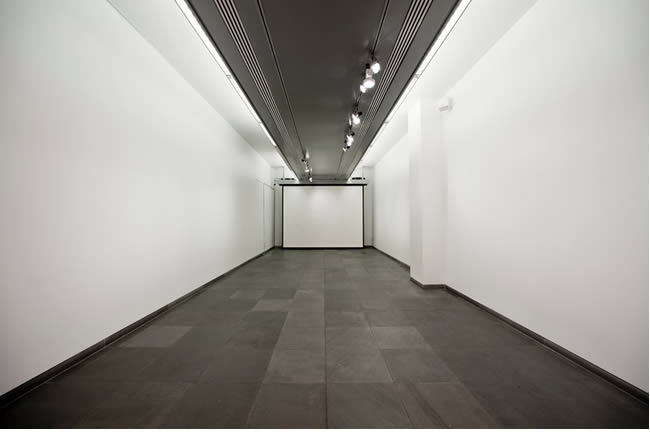Raimund Abraham (1933 – 2010)
Native born Austrian architect Raimund Abraham, who designed the Austrian Cultural Forum in New York, acclaimed as one of the most notable New York buildings in decades, died on March 4, 2010.
Raimund Abraham (1933 - 2010). Austrian Cultural Forum, NY
He was known primarily for his many visionary drawings of architectural utopias which was captured in his statement - “I don’t need a building to validate my ideas; all I need is a pencil and piece of paper.” He was interested in the architecture of ideas more than the buildings themselves and his influence on a generation of students of architecture was recognized by the prestigious academic institutions where he taught. The Austrian Cultural Forum in New York He co-designed (with Giuliano Fiorenzoli) the Rainbow Plaza in Niagara Falls and the interior renovation of the Anthology Film Archives in New York, but became most famous as the architect of the Austrian Cultural Forum on East 52nd Street in New York, completed in 2002.
A building 25 ft. wide and 24 stories tall on a site less than 100 feet deep, he once described the Austrian Cultural Forum building as “a cross between a ‘Blade Runner’ and an Easter Island sculpture.” At other times he likened its cascading sheet-glass facade to a “falling guillotine,” a description reflecting a touch of the Austrian irony used as a mechanism of critical thinking: “The whole shaft of the skyscraper was designed as one gigantic Doric column,” mirroring the tradition of aesthetics,” while using modern technology to build it. “Irony needs to be present but never clearly so,” Abraham once remarked.
The twenty-four story tower, known for its façade of sloping tinted-glass louvers that seem suspended as if defying the laws of gravity, is framed in glass and steel. In an interview with members of the Cultural Forum prior to its opening in 2002, he described the adventure and difficulty of building in New York and viewed his biggest challenge as “resolving the extreme condition of the smallness of the site,” while “attempting an architectural gesture of grandeur while at the same time providing the utmost functional use.”
He was challenged to design to the highest degree of precision. The result was what architectural historian Kenneth Frampton, who served on the jury that chose Mr. Abraham for the commission, called “the most significant modern piece of architecture to be realized in Manhattan since the Seagram Building and the Guggenheim Museum built in 1959.”
Director of the Austrian Cultural Forum Andreas Stadler highlighted that Abraham “not only helped to shape the New York skyline but also helped shape the way in which Austria as a nation viewed contemporary creativity.” Remnants of Raimund Abraham’s Austrian past, memories of which are celebrated in a book entitled, “Elementare Architektur” (1963), can clearly be detected in his architectural drawings.
He was born on July 23, 1933, in Lienz, (Tyrol) Austria. The experience of living through WW II as a child left an indelible mark on him. “I had horrifying experiences that shaped my aesthetics. I saw the entire sky covered with airplanes and buildings disappear that were supposed to be permanent,” he remarked during an interview with the Cultural Forum. Later he would channel his energies into detailed, darkly shaded drawings of visionary projects like an explorer of the gloomier chambers of the human soul.
His leanings and interest in architecture as a pure discipline rooted in concise architectural theory can be traced back to his study of architecture at the Technical University in Graz. From 1958 – 1964 he worked out of an architectural studio in Vienna, where he soon emerged as one of the exponents of the new Viennese Avant-garde Architecture. This phase of his career was captured in an exhibit by the Museum of Modern Art (MOMA) in 1967 in which he was pictured working together with Hans Hollein and Walter Pichler.
In 1964 he took up residence in the United States, where he taught at the Rhode Island School of Design and from 1971 at the Cooper Union in Manhattan and the Pratt Institute in Brooklyn. In 2003 he became a visiting faculty member of the Southern California Institute of Architecture. Academic life enabled him to pursue his artistic and scholarly interest in architecture with an emphasis less on building than on thought expressed through drawings, sometimes accompanied by poetic texts.
Federal Chancellor Werner Faymann and Minister of Culture Claudia Schmied gave recognition to his visionary strength, his clear, uncompromising position not only in matters of architecture but also in his world views and his international standing. “Throughout his entire life, he was singularly and unconditionally committed to architecture’s autonomy, opening up new dimensions of artistic vision,” claimed director of the Vienna Center of Architecture Dietmar Steiner.
ACF Main Gallery. Austrian Cultural Forum, NY



